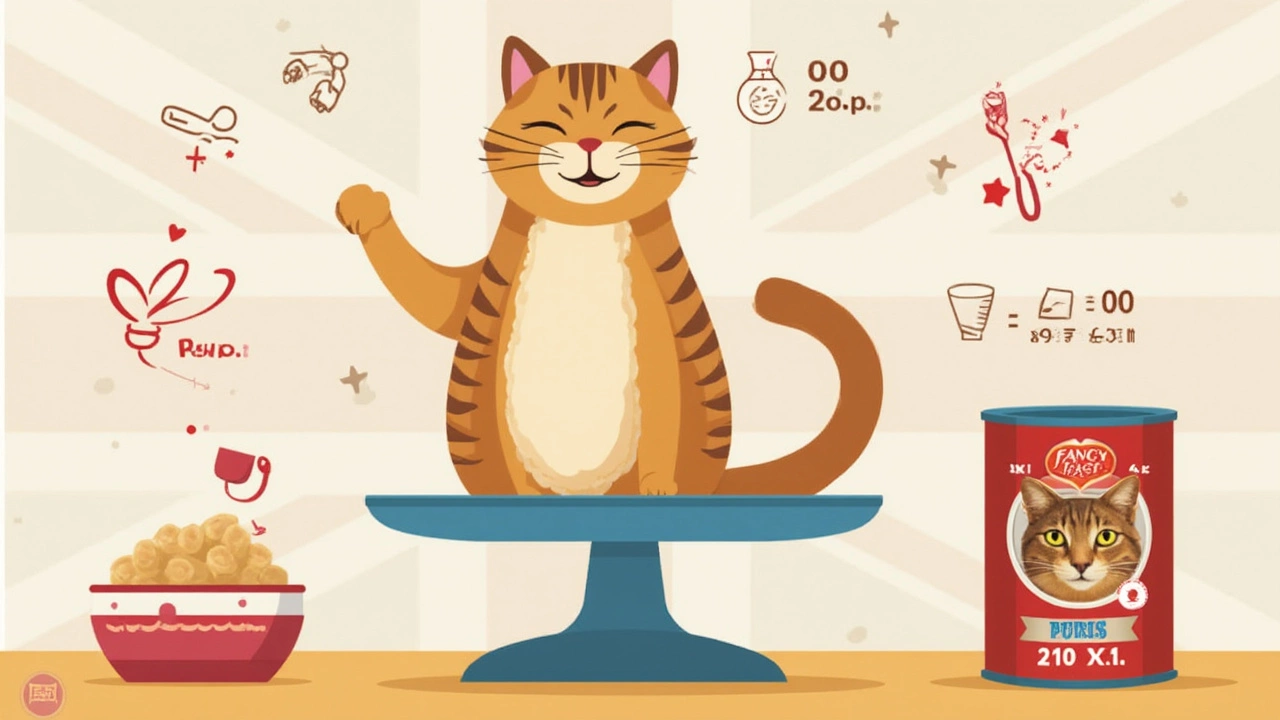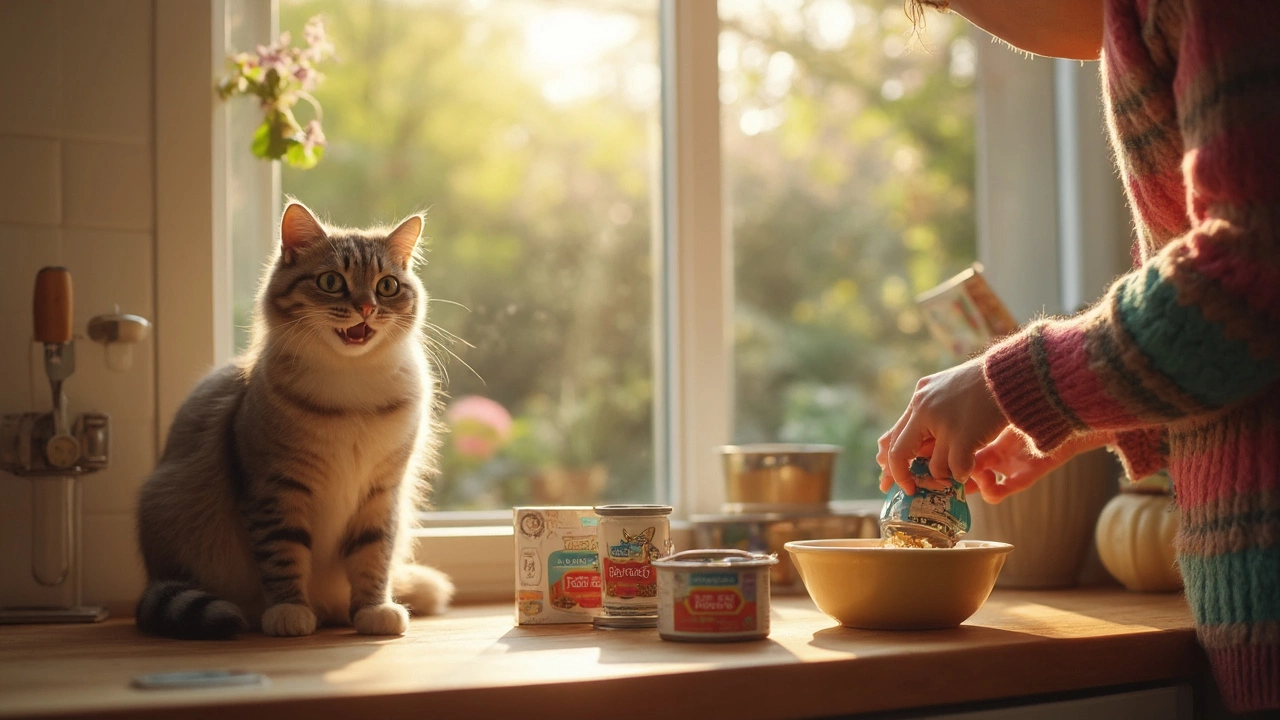If you’re staring at a stack of Fancy Feast cans and wondering if your 10 pound cat is eating the right amount, you’re not alone. Cat food labels aren’t always clear, and nobody wants to overfeed or underfeed their furball.
Here’s the deal: A typical can of Fancy Feast contains about 85 calories. Most adult cats need around 20 calories per pound of body weight daily, so a 10 pound cat usually needs about 200 calories a day. Doing the math, that’s just a little over two cans every 24 hours. Most people split that into two or three meals—whatever works best for your schedule and your cat’s appetite.
- Figuring Out Serving Size for a 10 Pound Cat
- Understanding Canned Food Calories and Labels
- Tips for Feeding and Monitoring Your Cat
- Signs Your Cat Needs More or Less Food
Figuring Out Serving Size for a 10 Pound Cat
The feeding chart on any can of Fancy Feast is a decent starting point, but it’s not a one-size-fits-all deal. For most healthy 10 pound adult cats, you’re looking at about 200 calories a day. Since each can of Fancy Feast is about 85 calories, two to two-and-a-half cans per day generally hits the mark.
But hang on—it’s not just about the math. You need to check if your cat is a couch potato or a wild child. If your cat is super lazy, you might want to stick closer to two cans, maybe a tiny bit less. If your cat tears around the house every night or spends time outside, a full two and a half cans could be right.
Here’s a quick way to break it down:
- For indoor cats with low activity: Around 2 cans a day (170 calories).
- For average or moderately active cats: 2 to 2.5 cans a day (170–210 calories).
- For super active or outdoor cats: Up to 2.5 cans a day (210 calories), but talk to your vet if you think they need more.
Always divide the total into two or three meals to avoid stomach issues. It helps keep them satisfied and cuts down on scarf-and-barf episodes. Remember, kittens, pregnant cats, and seniors need different amounts—these guidelines are for healthy adult cats only.
Understanding Canned Food Calories and Labels
Canned cat food labels can look complicated, but learning how to read them makes feeding way easier. The first thing to look for is the calorie content, usually listed as "calories per can" or "kcal/can" on the label or the brand’s website. Fancy Feast classic pâté, for example, usually comes in 3-ounce cans, each with about 85 calories. Some other flavors or types might have a few more or less, so it's smart to check if you’re switching up your cat’s menu.
Most adult indoor cats need about 20 calories for each pound they weigh. That means a 10 pound cat should get right around 200 calories daily—so if you stick with Fancy Feast, that’s about two and a half cans. Simple math, but super important for keeping your cat’s weight just right. It can be tempting to offer more if your cat seems hungry, but stick to the calorie count, not just how fast your cat empties their bowl.
If you’re ever unsure, turn the can around and look at the ingredient list too. The first ingredient should always be a real protein like chicken, beef, or fish. Skip the ones loaded with fillers like corn or by-products. Also, some Fancy Feast cans will show feeding guidelines, but those are just starting points. Your cat’s activity, age, and overall health play into how much food they’ll need every day.
Bottom line: pay attention to both calories and ingredients. It’s the easiest way to pick the right amount and healthiest variety of wet food for your cat.

Tips for Feeding and Monitoring Your Cat
Keeps things simple—cats thrive on routine. Set mealtimes around the same hours each day, and don’t just leave food out all the time. Scheduled feeding lets you notice fast if your cat’s appetite changes, which can signal health problems.
- Split your cat’s daily food into two or three small meals. This helps digestion and keeps them satisfied.
- Always use clean bowls. Stainless steel or ceramic works best—plastic can hold smells and bacteria.
- Store unused Fancy Feast cans in the fridge. Cover them to keep flavors fresh. Let food come to room temp before serving to make it more appealing for your cat.
- Don’t forget water. Wet food adds moisture, but cats still need a bowl of fresh water nearby every day.
Keep an eye on your cat’s body shape. If their ribs, back, and spine are poking out, that’s a red flag your cat needs more food. If you press gently on their side and can’t feel ribs at all, cut back a little.
| Weight (lbs) | # of Cans per Day | Total Calories Needed |
|---|---|---|
| 8 | 1.9 | 160 |
| 10 | 2.3 | 200 |
| 12 | 2.7 | 240 |
If you worry about your cat’s weight, measure their meals with a digital kitchen scale. Sometimes those “heaping spoonfuls” aren’t as even as you think.
Keep track of your cat’s eating in a notebook or a phone app. Big changes—like suddenly leaving food behind, scarfing it all in seconds, or begging for more than usual—shouldn’t be ignored. Health problems sometimes pop up as appetite changes before anything else is obvious.
Last tip: stick to one type of Fancy Feast for a bit before switching up flavors or styles. Sudden changes can upset your cat’s stomach. If you want to try a new variety, mix a little at a time with the old until your cat adjusts.
Signs Your Cat Needs More or Less Food
It’s not always obvious when your cat’s getting too much or too little food. Even if you’re feeding a set amount of Fancy Feast every day, you need to watch your cat’s body and habits for the real answer. Cats don’t all burn calories the same way—even two 10 pound cats can have totally different needs depending on age, activity, and even the weather.
Keep an eye out for these red flags if you’re worried about meal portions:
- Visible ribs or spine and dull coat: Your cat might be underfed or not getting enough nutrients.
- Pudgy belly and no visible waist: Packing on the pounds is a sign they’re probably eating too much.
- Changes in behavior: Is your cat begging after meals or ignoring food altogether? That’s usually a clue something’s off.
- Lethargy or low energy: Not enough calories makes cats sleepier and less playful than usual.
- Frequent vomiting or loose stool: Sometimes, overeating or the wrong diet can upset your cat’s stomach.
You can also check your cat’s weight with regular weigh-ins. A healthy adult cat should stay at a stable weight, give or take half a pound. Sudden drops or jumps mean it’s time to adjust the food plan or chat with a vet.
| Sign | Possible Cause | Action |
|---|---|---|
| Ribs showing | Too little food | Increase daily cans |
| Round belly | Too much food | Cut back a bit |
| Low energy | Not enough calories | Evaluate meal size |
| Begging or scavenging | Hungry | Double-check portion |
| No interest in food | Full or unwell | Reduce portion or call vet |
Measuring and adjusting takes a little trial and error. If you ever feel stuck, pop over to your vet for a quick check-in—you’ll get practical tips for dialing in your cat’s meals to keep them healthy and happy.
